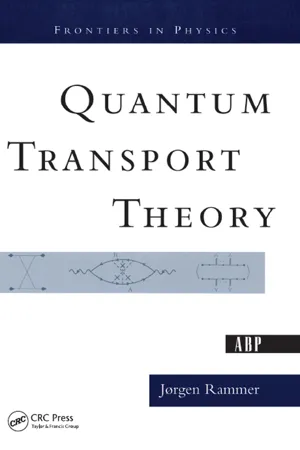
This is a test
- 540 pages
- English
- ePUB (mobile friendly)
- Available on iOS & Android
eBook - ePub
Quantum Transport Theory
Book details
Book preview
Table of contents
Citations
About This Book
This book provides an introduction to transport theory, the kinetic equation approach and shows the utility of Feynman diagrams in non-equilibrium quantum statistical mechanics. It is helpful for a wider audience than students of condensed matter physics and physicists in general.
Frequently asked questions
At the moment all of our mobile-responsive ePub books are available to download via the app. Most of our PDFs are also available to download and we're working on making the final remaining ones downloadable now. Learn more here.
Both plans give you full access to the library and all of Perlego’s features. The only differences are the price and subscription period: With the annual plan you’ll save around 30% compared to 12 months on the monthly plan.
We are an online textbook subscription service, where you can get access to an entire online library for less than the price of a single book per month. With over 1 million books across 1000+ topics, we’ve got you covered! Learn more here.
Look out for the read-aloud symbol on your next book to see if you can listen to it. The read-aloud tool reads text aloud for you, highlighting the text as it is being read. You can pause it, speed it up and slow it down. Learn more here.
Yes, you can access Quantum Transport Theory by Jorgen Rammer in PDF and/or ePUB format, as well as other popular books in Physical Sciences & Physics. We have over one million books available in our catalogue for you to explore.
Chapter 1
Quantum Mechanics
In this chapter an introduction to quantum mechanics is given. After a brief description of quantum mechanics, we follow Feynman in section 1.1, and deduce the content of quantum mechanics from the few basic principles using the path integral formulation. Having thus established the notions of quantum mechanics, we introduce in section 1.2 the formulation in terms of the operator calculus. The reader with this basic knowledge of quantum mechanics has the necessary tools for understanding the content of the rest of the book. The rest of this chapter is thus not necessary reading (except perhaps for consulting section 1.8 where the statistical operator and the density matrix are introduced). The main part of chapter 1 is thus for the reader not satisfied with the intuitive and deductive introduction to quantum mechanics presented in sections 1.1 and 1.2. In section 1.3 and 1.4 we follow Schwinger, and induce from a few experimental facts the kinematic structure of quantum mechanics, i.e., the notions needed for describing physical systems. In section 1.5 we show how nonrelativistic quantum kinematics emerges from the general theory. In section 1.6 we discuss how physical quantities are related to symmetries through unitary transformations, and consider translations in detail. The presentation in section 1.7 of quantum dynamics, i.e., how the properties of a physical system change in time, stresses the unitary equivalence aspect, and in section 1.8 we introduce the statistical operator and the density matrix. The last section gives an i...
Table of contents
- Cover
- Title Page
- Copyright Page
- Dedication
- Table of Contents
- Frontiers in Physics
- Editor’s Foreword
- Preface
- 1 Quantum Mechanics
- 2 Diagrammatic Perturbation Theory
- 3 Particle in a Random Potential
- 4 Kinetics in a Random Potential
- 5 Fermi Gas in a Random Potential
- 6 Particle in Oscillator Environment
- 7 Linear Response Theory
- 8 Linear Response of Disordered Conductors
- 9 Localization
- 10 Interactions in Metals
- 11 Weak Localization
- Appendices
- Bibliography
- Index